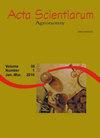Morpho-anatomical characterization, gene expression and protein cell wall modifications associated with natural finger drop in bananas
IF 1.2
4区 农林科学
Q3 AGRONOMY
引用次数: 0
Abstract
Banana (Musa spp.) is one of the main fruits consumed worldwide. However, finger drop, is a physiological disorder that causes many postharvest problems, which eventually reduces market value and consumer acceptance. Therefore, the objective of the study was to evaluate the anatomical changes that occur in the pedicel rupture area (drop zone) of bananas diploids (BB França) and tetraploid (BRS Pioneira) in three ripening stages. The levels of gene expression involved in the natural ripening process and in the development of finger drop, was also investigated. The accumulation of their mRNAs and those of expansin (EXP1), pectate lyase (PEL1) and xyloglucan endotransglucosylase/hydrolase protein (XTH4) genes already isolated from bananas were measured by quantitative polymerase chain reaction in three ripening stages. BB França presented a higher resistance to finger drop due to the presence of some specific morphoanatomical characteristics, such as larger parenchymal cells and greater deposition of lignin. In contrast, there was degeneration of the pedicel parenchymal tissue of the BRS Pioneira genotype, forming large empty spaces during the ripening of the fruits, mainly in stage 6, which contributed to the finger drop. The diploid BB França is a strong candidate for use in banana breeding programs aimed at fruit drop resistance. This will certainly improve the quality of banana varieties. Moreover, PEL1 proved to be an excellent candidate gene for functional studies of finger drop in bananas.形态解剖特征、基因表达和蛋白质细胞壁修饰与香蕉天然手指下垂相关
香蕉(Musa spp.)是世界上消费的主要水果之一。然而,手指掉落是一种生理障碍,会导致许多采后问题,最终降低市场价值和消费者接受度。因此,本研究的目的是评价香蕉二倍体(BB frana)和四倍体(BRS ira)在三个成熟阶段花蒂破裂区(落区)发生的解剖学变化。还研究了参与自然成熟过程和滴指发育的基因表达水平。采用定量聚合酶链反应法测定了3个成熟阶段的mrna积累量,以及已从香蕉中分离到的扩张蛋白(EXP1)、果胶裂解酶(PEL1)和木葡聚糖内转葡萄糖酶/水解酶蛋白(XTH4)基因的mrna积累量。由于存在一些特定的形态解剖特征,如更大的实质细胞和更多的木质素沉积,BB frana表现出更高的抗指滴性。而BRS pioneer基因型的花梗实质组织在果实成熟过程中(主要在第6期)发生了退化,形成了较大的空腔,导致了手指下垂。二倍体BB frandada是香蕉抗落果育种的有力候选品种。这肯定会提高香蕉品种的质量。此外,PEL1被证明是香蕉手指下垂功能研究的一个很好的候选基因。
本文章由计算机程序翻译,如有差异,请以英文原文为准。
求助全文
约1分钟内获得全文
求助全文
来源期刊

Acta Scientiarum. Agronomy.
Agricultural and Biological Sciences-Agronomy and Crop Science
CiteScore
2.40
自引率
0.00%
发文量
45
审稿时长
>12 weeks
期刊介绍:
The journal publishes original articles in all areas of Agronomy, including soil sciences, agricultural entomology, soil fertility and manuring, soil physics, physiology of cultivated plants, phytopathology, phyto-health, phytotechny, genesis, morphology and soil classification, management and conservation of soil, integrated management of plant pests, vegetal improvement, agricultural microbiology, agricultural parasitology, production and processing of seeds.
 求助内容:
求助内容: 应助结果提醒方式:
应助结果提醒方式:


